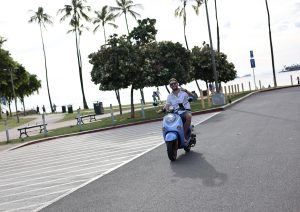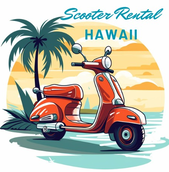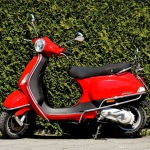Mopeds are known for their compact size, frugal fuel consumption, and ease of use. They come equipped with small engines, usually measured in cubic centimeters (CC). These engines are available in various sizes, and the size significantly influences a moped’s top speed.
In this article, I’ll answer the question: how fast does a moped go? I’ll discuss the factors that affect a moped’s speed, and offer some tips on how to maximize your moped’s speed without compromising safety or breaking any laws.
How Fast Does a Moped or Scooter Go?
The speed of a moped varies depending on several factors, including the type of moped, its engine size, and local regulations.
On average, most traditional mopeds designed for city and suburban use have a top speed of around 30 to 40 miles per hour (48 to 64 kph).
However, some high-performance mopeds or models with larger engines can reach speeds of up to 60 mph (96 kph) or even more. You’ll want to understand this very well in case you ever want to rent a scooter or moped.
Factors That Affect the Speed of a Moped
Here are the factors that determine how fast a moped can go:
Engine Size (CC) and Type
One of the most significant determinants of a moped’s speed is its engine size, measured in cubic centimeters (CC).
Mopeds typically come with either two-stroke or four-stroke engines.
Two-stroke engines, while often smaller in displacement, tend to provide more power per stroke, potentially allowing for higher speeds compared to their four-stroke counterparts.
Larger engine displacement generally equates to more power and higher top speeds.
Below is a table illustrating the average speeds for different moped engine sizes:
| Engine Size (CC) | Average Top Speed (MPH) |
| 50cc | 25 to 35 |
| 100cc | 35 to 45 |
| 150cc | 45 to 55 |
| 200cc | 55 to 65 |
| 250cc and above | 65+ |
Weight and Design
Lighter mopeds with streamlined designs tend to achieve higher speeds more effortlessly because they encounter less resistance and boast better power-to-weight ratios.
Manufacturers meticulously engineer the weight distribution and overall design of mopeds to strike the right balance between stability and speed.
Terrain and Road Conditions
Smoother, flat surfaces naturally allow for higher speeds, while rough or hilly terrain may hamper your ability to reach your moped’s maximum potential.
Climbing uphill will invariably be slower, whereas descending hills can provide opportunities to reach higher speeds, though you should always exercise caution and adhere to speed limits.
Maintenance
Neglecting maintenance can lead to reduced performance and slower speeds.
Keep a vigilant eye on crucial components such as the engine, brakes, tires, and chain to ensure they remain in good working condition.
Performing regular maintenance tasks, such as oil changes, spark plug replacements, and keeping the air filter clean, can help maintain or even enhance your moped’s speed over time.
Modifications and Upgrades
Moped enthusiasts often explore modifications and upgrades to squeeze more speed out of their rides.
Aftermarket parts like performance exhaust systems, carburetor upgrades, and high-flow air filters can provide additional power, resulting in increased top speeds.

Do You Need A License To Operate A Moped?
The requirement for a license to operate a moped varies by location and is subject to local regulations and laws.
In some regions, you may need a regular driver’s license, while in others, a simple moped-specific permit or endorsement on your standard driver’s license may suffice. The age at which you can legally operate a moped without a regular driver’s license also varies.
For example, in California, individuals are required to obtain an M1 or M2 motorcycle license and register their mopeds with the Department of Motor Vehicles (DMV). Moped owners must also have liability insurance in case of an accident.
Alabama residents need a motorcycle license to legally operate a moped, but liability insurance isn’t mandatory.
Meanwhile, riders in Delaware don’t need a special license to operate their mopeds. Liability insurance is also not required. You only need a valid driver’s license.
To determine the licensing requirements in your area, it’s essential to consult your local DMV or equivalent agency. They can provide you with accurate and up-to-date information regarding the necessary documentation and training needed to legally operate a moped in your jurisdiction.
Here’s a list of states in the USA where a license or permit is typically required to operate a moped:
- Hawaii Scooter Laws
- Florida
- South Carolina
- Georgia
- Alabama
- Mississippi
- North Carolina
- Virginia
- Maryland
- Connecticut
- Rhode Island
- New Jersey
- New York
- Pennsylvania
- Delaware
- Massachusetts
Tips for Maximizing Moped Speed
If you’re looking to get the most out of your moped and achieve higher speeds, there are several tips and strategies you can employ to optimize its performance. Keep in mind that these tips should always be practiced within the bounds of local laws and safety regulations.
Proper Maintenance
Regular maintenance is the foundation of a well-performing moped. Ensure your moped receives routine maintenance checks, including oil changes, spark plug replacements, and air filter cleaning.
A well-maintained moped is more likely to operate efficiently and reach its maximum speed.
Weight Management
The weight on your moped can significantly impact its speed.
Try to travel light and avoid carrying unnecessary items or cargo. Reducing excess weight will help your moped accelerate more quickly and reach higher speeds.
Tire Care
Pay attention to your tires. Proper tire maintenance, including maintaining the correct air pressure and ensuring good tread condition, is essential for safety and optimal speed.
Underinflated or worn-out tires can reduce your moped’s performance.
Upgrades and Modifications
Depending on local laws and regulations, consider exploring aftermarket parts and modifications that can enhance your moped’s speed.
Upgrades like performance exhaust systems, high-flow air filters, and carburetor adjustments can provide more power and boost top speed.
However, always ensure that any modifications you make are compliant with local laws.
Riding Techniques
Your riding techniques can also impact your moped’s speed.
Smooth and gradual acceleration, as well as maintaining a steady speed, can help maximize your moped’s efficiency.
Avoid sudden and aggressive maneuvers, as they can reduce fuel efficiency and hinder speed.
Aerodynamics
Your riding posture and the way you position your body on the moped can affect aerodynamics.
To reduce wind resistance, try to keep a low profile and tuck in when riding. This can help improve your moped’s overall speed and fuel efficiency.
Upgrade the Gear Ratio
Some mopeds allow you to adjust the gear ratio, which can impact speed. A higher gear ratio can improve top speed, while a lower one can improve acceleration. Experiment with different settings to find the balance that suits your riding style.
Legal Compliance
Ensure you’re aware of and comply with local laws regarding moped modifications, licensing, and speed limits. Riding responsibly within the legal limits is crucial for your safety and the safety of others on the road.
Scooter vs. Moped: What’s the Difference?
When it comes to two-wheeled urban transportation, scooters and mopeds are often used interchangeably.
However, they’re distinct vehicles with some key differences. Understanding these differences can help you make an informed choice when selecting the right option for your needs.
Engine and Power
Scooters come in a range of engine sizes, spanning from 50cc to 800cc or more, making them capable of achieving highway speeds.
In contrast, mopeds typically have smaller engines, typically 50cc or 100cc, and are primarily designed for lower-speed urban commuting, generally topping out at 30 to 50 mph.
Pedals
Scooters lack pedals entirely, relying solely on a throttle and brakes for propulsion and stopping.
Mopeds, as the name suggests, are equipped with pedals, allowing the rider to assist the engine by pedaling, particularly when starting from a stop or climbing steep hills.
Speed and Use
Scooters are versatile and can serve various purposes, from city commuting to long-distance travel, with the ability to achieve higher speeds suitable for highway use.
Conversely, mopeds are primarily designed for short-distance urban commuting, ideal for local errands, and not typically intended for highway travel due to their lower top speeds.
Design
Scooters come in a wide range of styles and sizes, including classic Vespa-style scooters, maxi-scooters for touring, and sportier models, allowing riders to choose based on their preferences and requirements.
Mopeds are comparatively limited in variety, typically focusing on basic, utilitarian designs tailored for urban use.
Licensing and Registration
Scooters may necessitate different licensing based on engine size and local regulations.
In many places, scooters with larger engines may require a standard motorcycle license.
Mopeds, on the other hand, often have their own category, and a special moped license or permit may be required in some areas, though the requirements are generally less strict than those for motorcycles.
Final Thoughts
Mopeds are designed primarily for urban commuting. These vehicles offer an excellent solution for short-distance travel within cities and towns, where congested traffic and short trips are the norm.
Their top speeds typically range from 30 to 50 miles per hour, based on engine size and other variables.
Smaller engines, such as a 50cc moped, tend to provide lower top speeds, typically around 30 to 35 miles per hour. These mopeds are ideal for short city trips, where agility and fuel efficiency are more critical than high speeds.
On the other hand, mopeds equipped with larger engines, like 100cc or more, can reach speeds closer to the 50-mile-per-hour mark.






